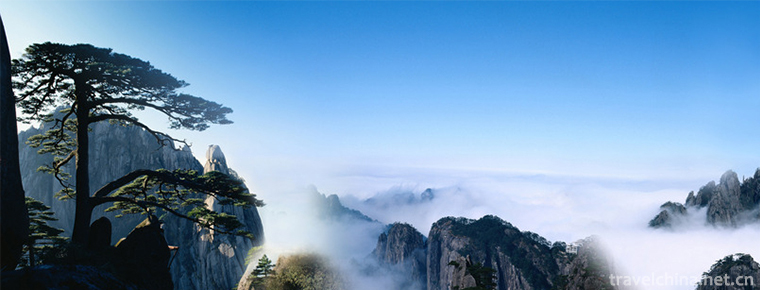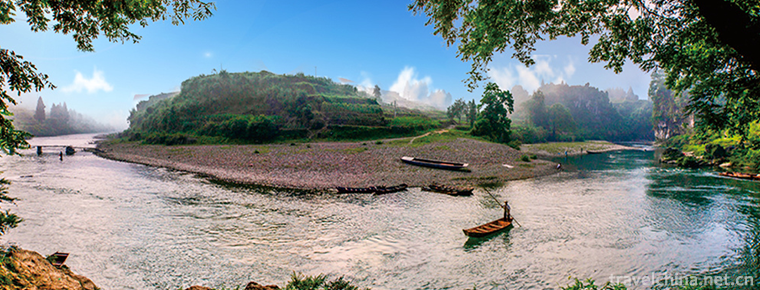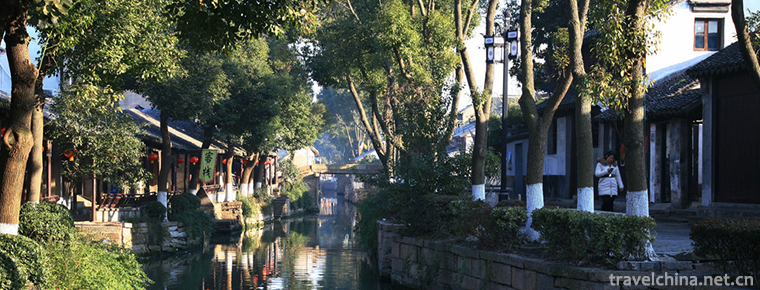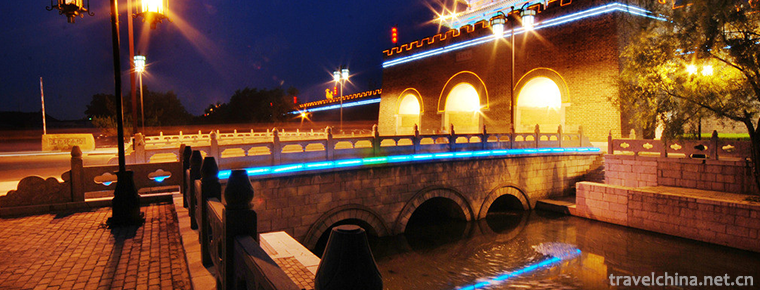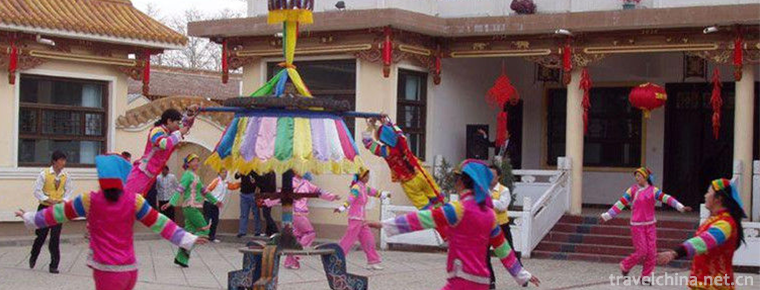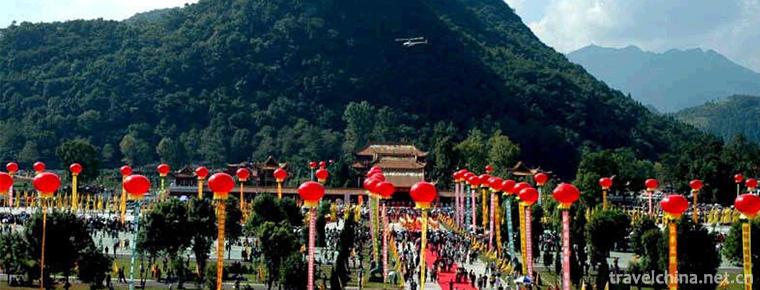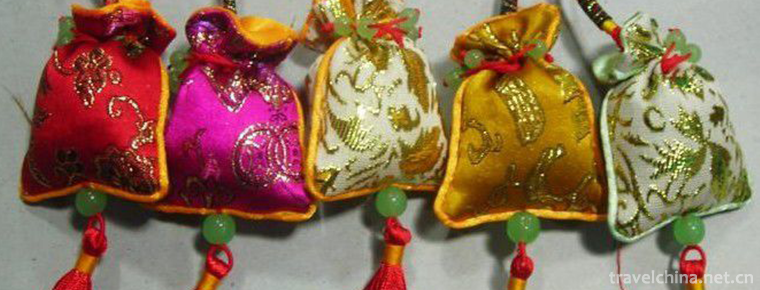The Lisu Knife and Rod Festival
The Lisu Knife and Rod Festival
The Lisu Knife and Rod Festival, which is called "A Tang De" in Lisu language, means "Climbing Dao Festival". It is a traditional festival of Lisu and Yi people living in Lushui County, Nujiang Lisu Autonomous Prefecture, Yunnan Province. The Festival is held on the 15th of the first month of each year.
The traditional festival of Lisu nationality is held every year on the eighth day of February in the lunar calendar. Popular in Baoshan area and Lisu Autonomous Prefecture of Nujiang, performers perform "Shangdaoshan" and "Xiashan" to show the spirit of the Lisu people not to fear hardship.
On May 20, 2006, the "Lisu Knife and Rod Festival" declared by Lushui County, Yunnan Province, was listed in the first batch of national intangible cultural heritage list with the approval of the State Council.
Introduction to Festivals
On the day of Knife-rod Festival, several strong men performed the ceremony of "crossing fire". They jumped barefoot into a burning fire.
Jump and roll, perform all kinds of stunts. The next day, they sharpened 36 long knives. The blades of the knives were tied to two 20-meter-high wooden poles with rattan upwards, forming a knife ladder. The performer climbs to the top with bare hands and feet from the edge of the sharp knife, and performs various difficult movements on the top of the pole. Nowadays, this thrilling traditional memorial ceremony has evolved into a sports activity for Lisu heroes to perform stunts.
Origin of Festivals
"Up to Daoshan, down to the sea of fire" is the main custom performance activity in the Daoshan Festival. It reproduces the life experience of mountain nationality crossing mountains and the arduous spirit of climbing Teng and negative Ge, and it is also a folk traditional custom activity.
Knife-pole Festival is a legendary commemoration of an ancient Han hero who was very grateful to Lisu people: Wang Li, Shangshu of the Ming Dynasty's Ministry of Military Affairs, was dispatched by the court to lead troops and horses to deploy joint military and civilian defense in Lisu people's living areas in Yunnan border area, to quell rebellion, to recover the occupied land, and with the cooperation of local people, to drive away the invading enemy. In order to make the border militia strong, he led Lisu youth to practice martial arts and bravery. Later, the emperor listened to the oracle and poisoned Wang Ji. The Lisu people have designated the death day of this hero as their traditional national festival, the Knife-pole Festival, and used symbolic ceremonies such as going up the knife hill and going down the sea of fire to express their willingness to go through fire and water to reciprocate.
"Knife-pole Festival" is an annual traditional festival for Lisu people in Lunma Mountain, Yunnan border area. The time is the eighth day of February in the lunar calendar. There is a legend about the origin of the knife-pole festival: in the Ming Dynasty, the imperial court dispatched the army department, Shangshu Wang Ji, to set up cards in the border areas. When Wang Shangshu arrived in office, he observed the sufferings of the border people and actively helped the Lisu people to develop production, so that their lives would be better and better, and they would be loved by the Lisu people. Later, Wang Shangshu was falsely accused by a treacherous minister and transferred back to the court. At the dust-washing banquet on the eighth day of February, Wang Shangshu was killed by an adulterer with poisonous wine. When this unfortunate news came to Lisu Mountain Village, people were so angry that they rubbed their fists and clapped their hands in order to revenge Wang Shangshu. The Lisu people decided that the eighth day of February, when Wang Shangshu was killed, would be the day for practicing martial arts. Every year on this day, martial arts practitioners practice their skills and teach advanced skills. So the knife bar joints are passed down from generation to generation. On the day of the festival, the Lisu people inside and outside dozens of miles, dressed in festival costumes, gathered from all directions to the knife pole farm by Yangchang River. When evening falls on the earth, many fires are burning inside and outside the knife pole field. Suddenly, four big fires in the center of the square burst into the air, illuminating the crowd in the spring. Then the Gong clanged, and the people on the knife-pole field joined hands with each other and danced a light tri-chord dance around the bright fire. When the four heaps of fire burned only red charcoal on the field, the host of the event announced the beginning of "jumping into the sea of fire". At this time, five brave men with bare feet rushed into the fire on the field immediately, bouncing constantly in it, rushing to step on countless sparks splashing everywhere, like flying meteors.
Then, the fire breakers with lightning speed, each hand stick red charcoal, respectively, in the face and body scrub, and then let the fireball fly in their hands to roll, rub. The crowds were sometimes cheerful, tense, admiring and surprised. There were bursts of applause. After a tense and intense performance, the female pile of charcoal was trampled into fragments and the flames were dying. The activity of "jumping into the sea of fire" came to an end. The next day, two safflower tree poles more than 20 meters high were erected on the tool pole field, and 36 long knives with upward blades were crossed between the trees. At noon, happy crowds filled the square again. With the announcement of the host, gongs, drums and firecrackers roared in the sky. Last night, five foggy men wearing blue caps, big and red robes rushed barefoot under the knife pole tree, filled with a glass of courageous wine and drank it. Then jump on the knife pole, grasp the upper blade with both hands, slant barefoot on the sharp edge of the lower layer, use the usual Qigong skills to support the sole of the foot, hand and foot alternately, step by step upward climbing. When the warriors climbed to the top of the pole, the audience gathered on the field, all staring and tongue-tied, and burst into a warm cheer.
The Lisu language is called "Atang De". It is held on the eighth day of February in the lunar calendar every year. It is prevalent in Yunnan, Fugong and other areas. At that time, men, women, old and young, dressed in national costumes, gathered in the knife pole square. Two thick wooden poles more than 20 meters long are erected on the square. 36 or 72 sharp knives are tied up on the poles with the knife edge facing upward to form a zigzag trapezoid. Where there are three or six places, the two knives are crossed into an X-shaped shape, with a small red flag and firecrackers hanging at the top of the pole. Most of the climbers are young and middle-aged. They wear red clothes, wear red cloth around their heads and have bare feet.
The climbing pole begins with the blazing fire and the echoing gongs. The young men jump barefoot into the fire and jump around in the fire. They are called "the sea of fire" and "the rolling fire". They also passed red chains from hand to hand, called "zippers". They pressed the flame on their faces with their hands, called "wash faces". After singing and dancing, the trained young man jumped barefoot on the knife pole, stepped on the sharp knife, climbed up with both hands, climbed up one by one, lit firecrackers at the top, threw the small flag to the cheering crowd and then down to the ground one by one. People came forward to offer good wine. Young people love songs and engage in social activities. Legend has it that this festival began in the Ming Dynasty. Wang Li, Shangshu of the Ministry of Military Affairs, led his troops to the Lisu people's living areas in Yunnan Province to recover the land occupied by foreigners and organize their compatriots to practice military self-defense. Queen Wang Ji was asked to be trapped and killed on the eighth day of February. In order to carry forward the brave and tenacious spirit of resisting the enemy, Lisu compatriots encouraged the brave spirit by climbing the knife pole to symbolize the activity of climbing the knife mountain and descending the fire sea, thus forming a fixed festival. In modern times, this activity has become a traditional sports activity of Lisu nationality.
Major activities
Every year on this day, people dress up in festival costumes and flock to the "Knife-rod Festival" venue to watch the "Upper Dao Mountain, Down Fire Sea" activities. "Up to Daoshan and down to the sea of fire" includes the steps of flower-lighting, knife-lighting, knife-playing, flower-greeting, altar-setting, knife-pole, vertical pole, dragon-worship, knife-loading, knife-folding and down to the sea of fire, among which there is a set of strict rituals. ShangDaoshan and XieHuoshai are the most exciting parts of the ceremony.
Go into the sea of fire
On the eve of Knife-rod Festival, the fire reflected the red sky, and the sound echoed in the valley. People poured into the fire from all sides to attend the opening ceremony of the knife-rod festival, the "Sea of Fire". In the bursts of firecrackers and gongs and drums, the first seven or eight "Xiangtong" (knife-stick performers) performed "fire dance" for the public. They are naked, barefoot, imitating all kinds of animal movements, bouncing back and forth on piles of red charcoal, sometimes wiping the charcoal on their bodies, rolling and rubbing round balls of fire in their hands. They jumped up and down in the fire without fear, and passed the red chains from hand to hand, showing their courage and fearlessness. The baptism of fire means eliminating all kinds of disasters in the new year.
Shangdaoshan
The next morning, the activity of "putting on the knife rod" was held. In the center of the venue, there are two large chestnut tree poles about 20 meters long. There are 36 sharp knives tied to the wooden poles. Each knife is about a yard apart. The blades of the knives are all facing upward, and the silver glitters, forming a daunting knife ladder. Just when people were in awe and worry, the sacrifices to the knife pole began. Several warriors in red clothes, red bald heads and barefoot walked down to the knife pole, knelt down in front of an ancient portrait of military generals, then raised their glasses over their heads, recited words in their mouths, and drank up the wine.
In the sound of firecrackers and gongs and drums, they jumped up, climbed up the knife pole lightly and agilely, pedaled barefoot on the sharp edge of the knife, grasped the knife ladder with both hands, and climbed up step by step. After they reached the top of the pole, they performed the opening of the Tianmen Gate, hanging red, and scattering valleys in turn. The first person to climb to the top is to make a difficult handstand and set off firecrackers. Thousands of spectators looked up and cheered from time to time. Finally, the people who "put on the knife pole" gathered at the top of the pole to show victory, and threw a small red flag in all directions, wishing Lisu's children good luck. Then they calmly stepped on the sharp blades and went down one by one. When they stood safely on the lawn, they looked at themselves with ease, without any damage to their skin and flesh.
Inheritance value
The knife-pole Festival is the product of the Lisu people's natural worship, and it is also the embodiment of the Lisu people's patriotism and the national spirit of fearing hardships and dangers. In festivals, the contents of primitive beliefs have been replaced by "ga-jumping", which shows healthy and novel lyrics and abundant hand dance movements, and has a wider mass character. This ancient and peculiar knife-rod joint has been officially designated as the traditional sports activities of Lisu people by the relevant departments.
The State attaches great importance to the protection of intangible cultural heritage. On May 20, 2006, the folklore was approved by the State Council and listed in the first batch of national intangible cultural heritage lists.

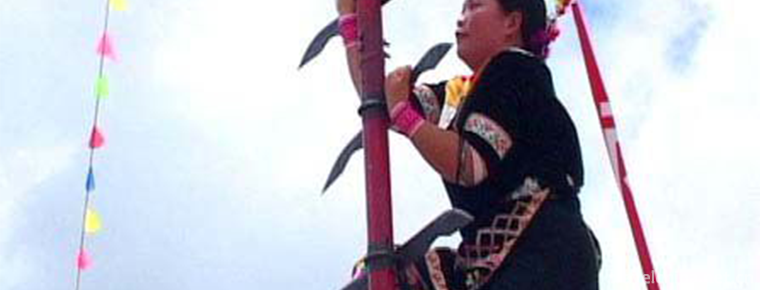
-
Mount Huangshan
Huangshan: World Cultural and Natural Heritage, World Geopark, National AAAAA Class Scenic Spot, National Scenic Spot, National Civilized Scenic Spot Demonstration Site, Top Ten Famous Mountains....
Views: 235 Time 2018-10-28 -
Ertan National Forest Park
Ertan National Forest Park is located in Yanbian County and Miyi County, the northern suburb of Panzhihua City, Sichuan Province, with a total area of 732.4 square kilometers .
Views: 137 Time 2018-12-22 -
Laosicheng Site
Laosicheng Site is located in Laosicheng Village, Lingxi Town, more than 20 kilometers east of Yongshun County, Tujia and Miao Autonomous Prefecture, western Hunan Province.
Views: 135 Time 2019-01-29 -
Luzhi Ancient town
Yongzhi Ancient Town belongs to Wuzhong District of Suzhou City. It is located in the east of Suzhou City. It is 18 kilometers west of Suzhou City and 58 kilometers east of Shanghai..
Views: 100 Time 2019-02-06 -
Sankong Tourist Area in the Old City of the Ming Dynasty
Qufuming Old City Tourist Area in Jining: World Cultural Heritage, one of the three holy cities in the world, national AAAAA-level tourist attractions, National Scenic spots.
Views: 241 Time 2019-02-07 -
Yasuaki
Anzhao is an ancient Tu dance. It's popular with mutual aid. When celebrating festivals, harvest celebrations and weddings, people gather in the courtyard or on the wheat threshing ground to dance the.
Views: 185 Time 2019-04-02 -
Hui Nationality Medicine
Hui medicine is the product of the combination of Chinese traditional medicine and Arab-Islamic medicine. Arabs began to develop science and culture when other European countries had not yet separated.
Views: 315 Time 2019-05-04 -
Linxia brick carving
Linxia brick carving (also known as Hezhou brick carving) is a practical art closely combined with buildings. Linxia brick carving matured in the Ming and Qing dynasties, and in modern times it absorb.
Views: 114 Time 2019-05-13 -
Sacrifice to Emperor Shun
Modern Shun Emperor Mausoleum sacrificial activities take the theme of "respecting ancestors and patriotism, inheriting civilization, uniting people's hearts and promoting development". The .
Views: 127 Time 2019-06-16 -
Sachet
Incense bag is also called odor-tolerant, incense bag, incense bag, incense sauce, Pei Mo. Nowadays people call it purse, toy and dim. It is a folk embroidery handicraft created by ancient Chinese wor.
Views: 187 Time 2019-07-03 -
Wenchuan earthquake epicenter site
The earthquake site, located in Yingxiu Town, Wenchuan, Sichuan Province, is open all day..
Views: 135 Time 2020-11-07 -
Luzhou natural resources
The total amount of water resources in Luzhou is 6.657 billion cubic meters per year. The groundwater reserves are rich, reaching 1.065 billion cubic meters per year, among which Xuyong and Gulin counties in the south are the richest. The structural fissure water in the south.
Views: 344 Time 2020-12-14
